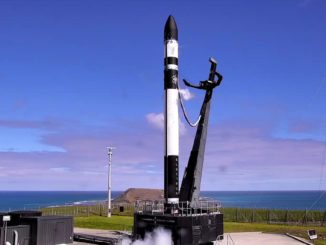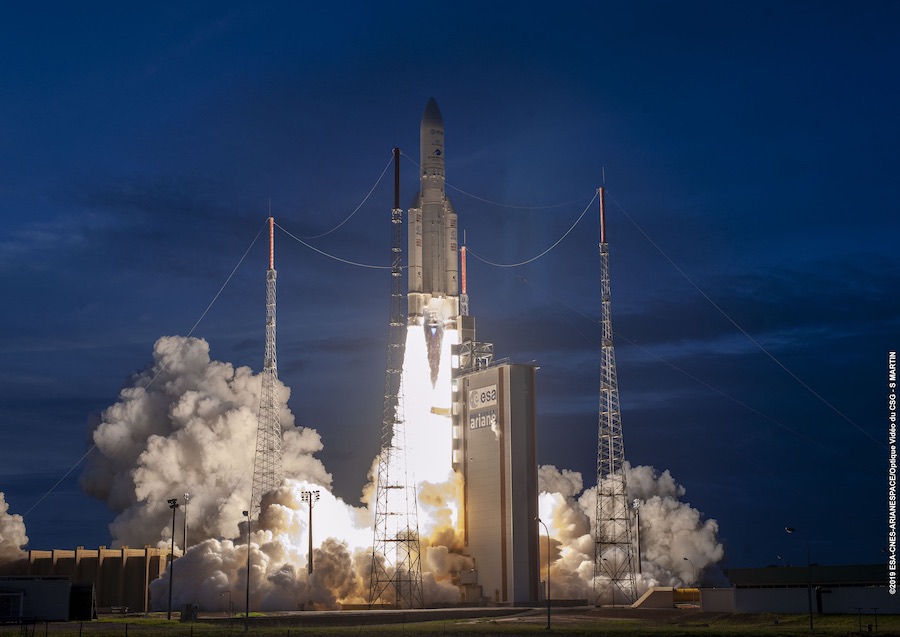
A pair of television broadcast satellites for AT&T and Eutelsat rocketed into orbit Thursday evening, riding a European Ariane 5 launcher into space in a spectacular sunset launch from the Guiana Space Center on the northeastern coast South America.
After a smooth 11-hour countdown, the Ariane 5’s Vulcain 2 main engine flashed to life at 2143 GMT (5:43 p.m. EDT; 6:43 p.m. French Guiana time) Thursday, followed by ignition of the launcher’s twin solid rocket boosters seven seconds later to force the heavy-lift vehicle into the sky.
The Ariane 5 leapt off the launch pad in Kourou, French Guiana, and pitched toward the east as it climbed through a picturesque orange sky at sunset, leaving in its wake a dark cloudy plume of exhaust.
The 179-foot-tall (54.8-meter) rocket jettisoned its two solid rocket boosters around 2 minutes, 20 seconds, into the flight. About a minute later, the two halves of the Ariane 5’s Swiss-made payload fairing separated from the rocket at an altitude of nearly 400,000 feet, or about 120 kilometers.
The unusually clear skies over the space base gave long-range tracking cameras unobstructed views of the boosters and fairing as they fell away from the rocket.
The Ariane 5’s core stage, burning liquid hydrogen mixed with liquid oxygen, continued firing until nearly nine minutes after liftoff. Then the first stage shut down its engine and separated to fall into the Atlantic Ocean, giving away to the rocket’s HM7B upper stage engine — also burning hydrogen fuel — for a 16-minute firing to inject the mission’s two satellite payloads into orbit.
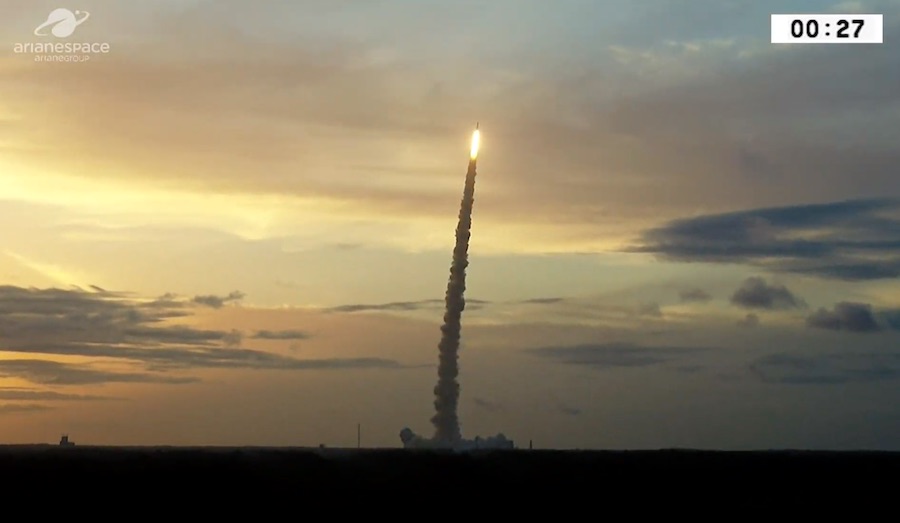
The HM7B engine switched off about 25 minutes after liftoff, and the upper stage maneuvered to the proper orientation to deploy AT&T’s T-16 television broadcast satellite.
Ground controllers confirmed separation of the T-16 satellite around 28 minutes into the flight, then the upper stage released a composite Sylda adapter structure to reveal Eutelsat 7C, which launched in the lower berth of the Ariane 5’s dual-payload accommodation.
Eutelsat 7C separated from the rocket around 34 minutes after launch, prompting a round of applause from the VIPs gathered at the Guiana Space Center.
Stephane Israel, CEO of Arianespace, confirmed the mission’s successful outcome moments later, announcing that both satellites were placed into on-target elliptical geostationary transfer orbits stretching more than 22,000 miles (nearly 36,000 kilometers) above Earth.
AT&T’s T-16 satellite and the Eutelsat 7C spacecraft will use their own propulsion to reshape their orbits, raising the low point, or perigee, altitude from around 150 miles (250 kilometers) up to geostationary altitude. Once in their circular orbits 22,000 miles over the equator, the satellites will revolve around the world at the same rate of Earth’s rotation, giving the relay stations a constant view of the same part of the planet.
Assembled in Toulouse, France, by Airbus Defense and Space, the T-16 satellite will activate its hydrazine-fueled main engine several times over the next week to reach geostationary orbit. Eutelsat 7C, manufactured by Maxar Technologies in Palo Alto, California, will rely in electric thrusters to take a longer, but more fuel-efficient, route to geostationary orbit lasting about four months.
T-16 is heading for an operating location over the Americas, while Eutelsat 7C’s coverage zone will include Europe, Africa, the Middle East and Turkey.
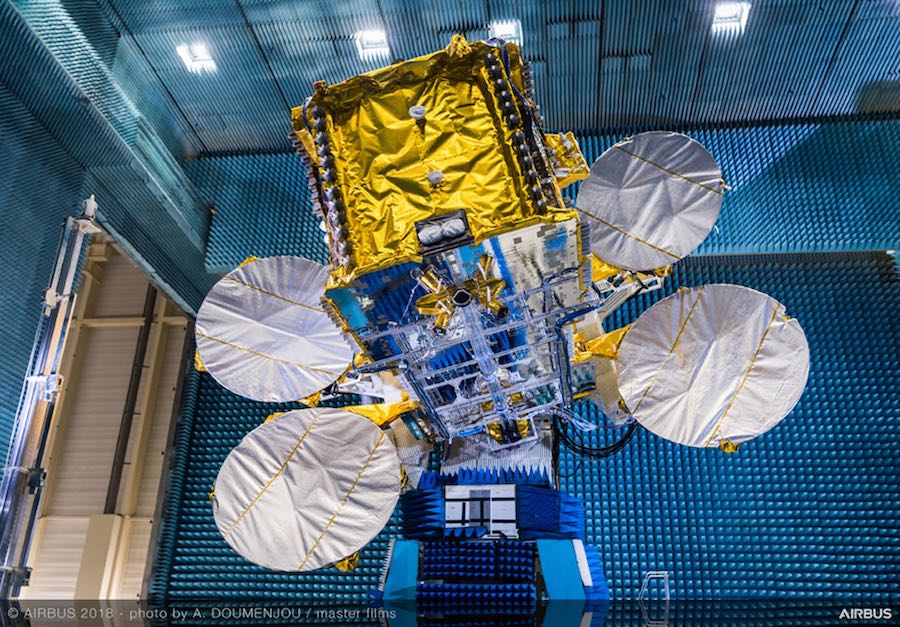
The T-16 spacecraft will join AT&T’s fleet of direct-to-home television broadcasting satellites, which were deployed by DirecTV before its acquisition by AT&T in 2015.
AT&T has released little information about the T-16 satellite or the future of the DirecTV service. In the months after AT&T acquired the satellite broadcast company in 2015, officials said they planned to begin phasing out the DirecTV brand.
Subscribers are also leaving AT&T’s pay-TV services as Internet-based video streaming options become more prevalent in the industry. In the first quarter of 2019, AT&T said it lost 544,000 customers from its DirecTV and AT&T U-verse product lines.
Bloomberg reported earlier this month that AT&T and DISH Network were open to a merger of the longtime competitors in the pay-TV market, which have both suffered subscriber losses in the last year. Citing unnamed sources, Bloomberg said representatives from both companies believe a merger would be approved by U.S. government regulators, although they added there were no active negotiations.
But there are still plenty of customers subscribing to AT&T’s pay-TV offerings. As of the end of March, AT&T’s DirecTV and U-verse services had 22.4 million subscribers.
AT&T’s T-16 satellite is based on Airbus’s Eurostar 3000 LX spacecraft platform, with a conventional chemical orbit-raising engine and electric thrusters for station-keeping maneuvers. According to Arianespace’s press kit for Thursday’s launch, the T-16 spacecraft weighs 13,955 pounds (6,330 kilograms) fully fueled with propellants.
Designed for a 15-year lifetime, AT&T’s T-16 satellite carries Ku-band and Ka-band broadcast payloads to reach consumers in the continental United States, Alaska, Hawaii and Puerto Rico.
In a regulatory filing submitted to the Federal Communications Commission last month, AT&T asked regulators for authorization to park the T-16 satellite in geostationary orbit over the equator at 100.85 degrees west longitude, where the spacecraft will orbit the Earth at the same rate as the planet’s rotation.
AT&T said the T-16 satellite will be co-located with the T-4S, T-8 and T-9S broadcasting satellites at the 101 degrees west position. The new spacecraft will take over from the T-15 satellite, which launched in 2015.
Documents submitted to the FCC by AT&T indicate the T-15 satellite was moved last year from a location at 103 degrees west to 101 degrees. The T-15 satellite will leave the 101 degrees west location for another posting in geostationary orbit about a month after T-16 arrives at its operating post, according to the FCC filing.
AT&T did not respond to questions from Spaceflight Now on the T-16 satellite or the future of the company’s satellite broadcast service.
“T-16 is one of our most powerful direct to home broadcast satellites, with a record number of +180 high-power amplifiers,” said Jean-Marc Nasr, head of Airbus Space Systems, in a statement. “T-16 will be able to broadcast hundreds of UltraHD 4K video services to end customers spread across the USA.
“Our Eurostar satellites have already clocked up more than 800 cumulative years of operational service in orbit,” Nasr said. “This is a true double success for us — as we also celebrate the 104th launch of the Ariane 5.”
“The job is not over,” said Aziz Bouhia, vice president and head of Airbus’s telecom satellites program. “Our team back in Toulouse is working … to raise T-16 into its final orbital slot and to do all the in-orbit testing during the summer, and then the spacecraft will be fully operational at the end of August.”
The 7,500-pound (3,400-kilogram) Eutelsat 7C satellite is destined for an operating post in geostationary orbit at 7 degrees east longitude. Eutelsat 7C’s coverage zone will include Africa, Europe, the Middle East and Turkey.
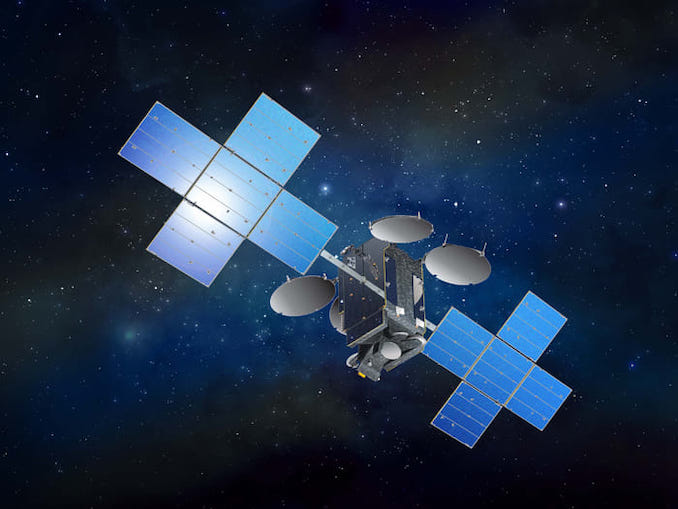
Paris-based Eutelsat says the new satellite hosts more than 40 Ku-band transponders to serve video and data markets. Eutelsat 7C will be co-located with Eutelsat 7B at the 7 degrees east position, and the aging Eutelsat 7A satellite — launched in 2004 — will fly to another location in geostationary orbit, according to Eutelsat.
“This satellite will be located at 7 degrees east, one our most dynamic video neighborhoods, which already broadcasts 500 channels and serves key customers such as Digiturk in turkey, AzamTV in Tanzania and Muvi TV in Zambia,” said Yohann Leroy, deputy CEO and chief technical officer of Paris-based Eutelsat. “We look forward to putting it into service to continue building the momentum at this orbital location.”
“By significantly increasing capacity over sub-Saharan Africa, Eutelsat 7C will have room for several hundred additional digital channels to support the region’s fast expanding TV market,” Eutelsat wrote on its website. “It will also be equipped with a beam providing enhanced capacity for government services over Europe, the Middle East and Central Asia, as well as a steerable beam that can cover any region visible from 7 degrees east.”
Eutelsat 7C is Maxar’s first satellite with an all-electric propulsion system. The low-thrust, high-efficiency plasma thrusters consume less propellant than conventional chemical rocket engines, allowing Eutelsat 7C to carry a lighter fuel load and giving Eutelsat access to a cheaper launch opportunity.
“All-electric satellites provide efficient solutions for satellite operators by reducing launch mass while increasing spacecraft flexility and performance,” said Arlen Kasighian, the satellite mission manager at Eutelsat. “Eutelsat has been a pioneer in all-electric platforms since 2015, collaborating with many major satellite providers.”
A Eutelsat communications satellite launched in 2015 was one of the first two commercial all-electric spacecraft built by Boeing.
The drawback of all-electric propulsion is the longer transit time to geostationary orbit. Instead of taking a few weeks to boost itself into its final operating orbit, Eutelsat 7C’s journey to geostationary orbit will last around four months.
“Based on Maxar’s decades-proven 1300-class platform, Eutelsat 7c is equipped with 44 Ku-band transponders and a steerable antenna beam, which enables Eutelsat to adjust coverage as needed while the satellite is on orbit,” said Paul Estey, Maxar’s chief operating officer. “The satellite also carries a highly innovative photonics payload which will demonstrate technologies to enable more efficient payload designs in the future.”
Estey said Eutelsat 7C is also the first satellite to carry Maxar’s more powerful second-generation lithium-ion power system.
Eutelsat 7C also hosts an instrument from CNES, the French space agency, to collect radiation data in space.
“This mission, named CARMEN-4, seeks not only to measure the space environment in geostationary orbit but also and above all to characterize it throughout the orbital positioning phase using the satellite’s electric thrusters each time it crosses the radiation belts,” CNES said in a press release. “This unprecedented experiment will improve spatial coverage of spectrometry data on proton and electron fluxes.”
Thursday’s launch was the second Ariane 5 flight of the year, and Arianespace’s fifth mission overall in 2019, including launches by Soyuz and Vega rockets from French Guiana.
“I think we can also celebrate tonight the friendship between the U.S. and Europe because it’s a perfect teaming,” Israel said Thursday night. “We have a U.S. customer and U.S. satellite manufacturer, and a European customer and a European satellite manufacturer. This is one of the beauties of Ariane to do this kind of achievement.”
Arianespace has two missions from French Guiana scheduled for July.
On July 5, an Italian-built Vega launcher is set for liftoff with the Falcon Eye 1 military reconnaissance satellite for the United Arab Emirates.
The next Ariane 5 launch is scheduled for July 24 with the Intelsat 39 communications satellite and the EDRS-C spacecraft, the first dedicated satellite for the European Data Relay System developed by Airbus and the European Space Agency.
Email the author.
Follow Stephen Clark on Twitter: @StephenClark1.


